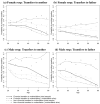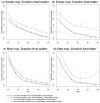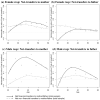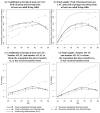Intergenerational transfers in the era of HIV/AIDS: Evidence from rural Malawi
- PMID: 23606809
- PMCID: PMC3628805
- DOI: 10.4054/demres.2012.27.27
Intergenerational transfers in the era of HIV/AIDS: Evidence from rural Malawi
Abstract
Background: Intergenerational transfer patterns in sub-Saharan Africa are poorly understood, despite the alleged importance of support networks to ameliorate the complex implications of the HIV/AIDS epidemic for families.
Objective: There is a considerable need for research on intergenerational support networks and transfers to better understand the mechanisms through which extended families cope with the HIV/AIDS epidemic and potentially alleviate some of its consequences in sub-Saharan Africa, and to comprehend how transfers respond-or not-to perceptions about own and other family members' health.
Methods: Using the 2008 round of the Malawi Longitudinal Study of Families and Health (MLSFH), we estimate the age patterns and the multiple directions of financial and non-financial transfer flows in rural Malawi-from prime-aged respondents to their elderly parents and adult children age 15 and up. We also estimate the social, demographic and economic correlates of financial and non-financial transfers of financial intergenerational transfers in this context.
Results and conclusions: Our findings are that: (1) intergenerational financial and non-financial transfers are widespread and a key characteristic of family relationships in rural Malawi; (2) downward and upward transfers are importantly constrained and determined by the availability of transfer partners (parents or adult children); (3) financial net transfers are strongly age-patterned and the middle generations are net-providers of transfers; (4) non-financial transfers are based on mutual assistance rather than reallocation of resources; and (5) intergenerational transfers are generally not related to health status, including HIV positive status.
Figures








Similar articles
-
"I am adhering to HIV treatment so that I can live to support her": A qualitative study of upward intergenerational support in South Africa.J Glob Health. 2024 May 10;14:04083. doi: 10.7189/jogh.14.04083. J Glob Health. 2024. PMID: 38726557 Free PMC article.
-
Cohort Profile: The Malawi Longitudinal Study of Families and Health (MLSFH).Int J Epidemiol. 2015 Apr;44(2):394-404. doi: 10.1093/ije/dyu049. Epub 2014 Mar 16. Int J Epidemiol. 2015. PMID: 24639448 Free PMC article.
-
Elderly support and intergenerational transfer in Zimbabwe: an analysis by gender, marital status, and place of residence.Gerontologist. 1991 Aug;31(4):505-13. doi: 10.1093/geront/31.4.505. Gerontologist. 1991. PMID: 1894155
-
Scoping Review: Intergenerational Resource Transfer and Possible Enabling Factors.Int J Environ Res Public Health. 2020 Oct 27;17(21):7868. doi: 10.3390/ijerph17217868. Int J Environ Res Public Health. 2020. PMID: 33121044 Free PMC article.
-
HIV/AIDS, declining family resources and the community safety net.AIDS Care. 2009;21 Suppl 1:34-42. doi: 10.1080/09540120902927593. AIDS Care. 2009. PMID: 22380977 Review.
Cited by
-
Disability transitions and health expectancies among adults 45 years and older in Malawi: a cohort-based model.PLoS Med. 2013;10(5):e1001435. doi: 10.1371/journal.pmed.1001435. Epub 2013 May 7. PLoS Med. 2013. PMID: 23667343 Free PMC article.
-
Divorce, living arrangements, and material well-being during the transition to adulthood in rural Malawi.Popul Stud (Camb). 2019 Jul;73(2):261-275. doi: 10.1080/00324728.2018.1545919. Epub 2019 Mar 1. Popul Stud (Camb). 2019. PMID: 30821638 Free PMC article.
-
Does Parents' Union Instability Disrupt Intergenerational Advantage? An Analysis of Sub-Saharan Africa.Demography. 2020 Apr;57(2):445-473. doi: 10.1007/s13524-019-00854-7. Demography. 2020. PMID: 32034724
-
Childlessness and upward intergenerational support: cross-national evidence from 11 European countries.Ageing Soc. 2019 Jun;39(6):1219-1254. doi: 10.1017/S0144686X17001519. Epub 2018 Jan 11. Ageing Soc. 2019. PMID: 31130759 Free PMC article.
-
Offspring schooling associated with increased parental survival in rural KwaZulu-Natal, South Africa.Soc Sci Med. 2017 Mar;176:149-157. doi: 10.1016/j.socscimed.2017.01.015. Epub 2017 Jan 16. Soc Sci Med. 2017. PMID: 28153751 Free PMC article.
References
-
- Agree EM, Biddlecom AE, Chang MC, Perez AE. Transfers from older parents to their adult children in Taiwan and the Philippines. Journal of Cross-Cultural Gerontology. 2002;17(4):269–294. doi:10.1023/A:1023085818629. - PubMed
-
- Ankrah EM. The impact of HIV/AIDS on the family and other significant relationships: The African clan revisited. In: Bor R, Elford J, editors. The Family and HIV. Cassell; New York: 1994. pp. 23–44. - PubMed
Grants and funding
LinkOut - more resources
Full Text Sources
